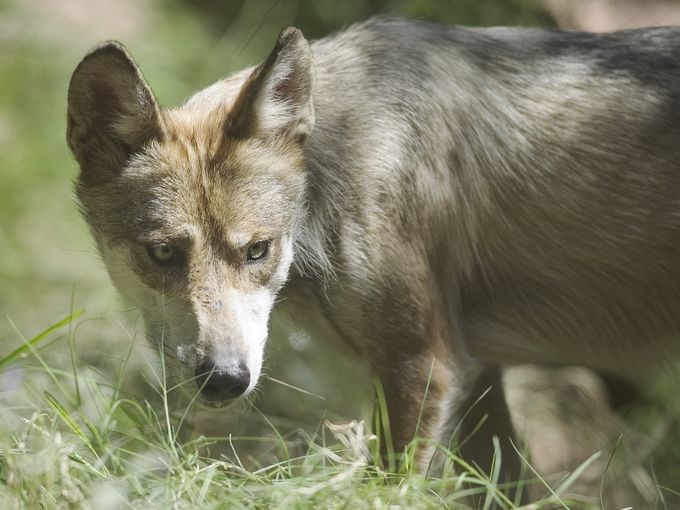Two more Mexican wolves
have been found dead.
Ranchers are no different from any other small business owner to hear them tell it. Ranchers operate on razor-thin margins, and a host of calamities — including drought, storms and disease — can turn profit to loss overnight???
The huge difference here is other businesses dont survive off of Taxpayers. If other businesses cant make it they go bankrupt and find something else to do… Not cry to the Government for more bailouts.
Which mean left-leaning environmental groups are distraught and traditionally conservative ranchers are cheering.
The news came in an Arizona Game and Fish press release issued Sept. 14. Both deaths occurred in August; cause of death was not disclosed, and both are currently under investigation. The wolf found dead in Arizona is from the Tsay-O-Ah pack, while the wolf found dead in New Mexico is from the Elk Horn pack, which is an Arizona pack located in the Apache-Sitgreaves National Forest.
The two new deaths bring the total number of wolf deaths in 2018 to eight.
For about 20 years, U.S. Fish and Wildlife has been trying to re-establish the Mexican gray wolf in parts of Arizona and New Mexico, with the Blue Primitive Area in Greenlee County being ground zero for the program.
As of the end of 2017, there were 114 wolves in the wild, with, as of August, 70 with functioning radio collars.
Arizona has 10 different packs, all located within the Apache-Sitgreaves National Forest, with two documented loan wolves in forest as well. New Mexico has 14 different packs with two additional documented loan wolves.
Which means Graham and Greenlee ranchers have had to deal with a predator they hadn’t dealt with prior to 1998. And ranchers do have to deal with the wolf. Arizona Game and Fish confirmed two “depredation incidents on livestock” in August — which means wolves killed cattle — as well as two nuisance indents.
Since January, it’s confirmed that Mexican wolves have killed livestock 56 times in New Mexico and 24 times in Arizona.
We throw all those statistics around to give you an idea why ranchers are so upset about the Mexican Wolf Reintroduction Program.
It’s not unusual to hear stories of wolves terrifying small children as they wait for the school bus, but those stories are just that — stories. There are no confirmed incidents of Mexican wolves threatening any humans, just “I heard from my neighbor a story that he heard from . . .” stories.
However, when an agency tasked with overseeing the program at the state level reports livestock kills, it’s not rumor; it’s fact.
Ranchers are no different from any other small business owner. Ranchers operate on razor-thin margins, and a host of calamities — including drought, storms and disease — can turn profit to loss overnight. Ranchers do not need the addition of a predator that many believe is not historically native to the area.
The wolf, opponents say, belongs in Mexico, not Arizona and New Mexico, and point to wolf population growth in Mexico (at about 16 percent year to year) as evidence.
During a candidate forum in Willcox last week, state Rep. Becky Nutt, R-Clifton, said it’s time to redefine what constitutes an endangered species and how those endangered species impact farmers and ranchers. She used the Mexican wolf as an example.
This is one of those instances where we agree with Nutt. She knows, and with this we agree, that farmers and ranchers (along with hunters) are the best conservationists around. If they believed the wolf belonged in the area and served a purpose — such as battling with other predators to achieve balance — farmers and ranchers would not oppose helping the wolf thrive.
The recovery plan calls for at 300 wolves in the wild, and environmental groups say that number is too low. In addition, they are suing to expand the recovery area to the northern parts of both states in an effort to accommodate a greater number of wolves.
We would like to see the courts reject the environmental groups’ suit and, instead, roll back the current plan to a recovery area of just Mexico.
After 20 years of wolf population unable to grow without human interference, the Mexican Wolf Recovery Program is an obstacle area ranchers just don’t need.
Source: Editorial: USFWS needs to listen — really listen — to ranchers | Editorials | eacourier.com

Comments
I may have wrote this already but anyway…start petition…https://animalpetitions.org/start-a-petition/
Ugh, enough is enough…Stop killing the wolves….Because I plan to stop eating beef….forever, if I have to…I will NOT support ranchers’ lust for killing wolves…These animals have had a long enough road to recovery as it is, without ranchers killing them off every chance they get.